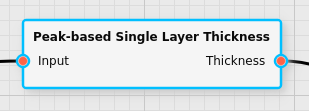Peak-based Single-Layer Thickness Filter
The Peak-based Single-Layer Thickness Filter calculates the thickness of a semi-transparent film on a substrate by analyzing the oscillations in the spectrum caused by the interference pattern generated by the film.
Category |
|
Node |
|
Parameters |
Minimum Thickness: The minimum thickness to consider. (In micrometers.) Maximum Thickness: The maximum thickness to consider. (In micrometers.) Precision: Whether the filter should optimize for performance (Coarse) or accuraccy (Fine). Average Refractive Index: The average value of the refractive index of the film material. |
Inputs |
Input: spectral reflectance data |
Outputs |
Thickness: the thickness of the film material (in micrometers) |
Effect of the Filter
The filter assumes that a single film is present that has a refractive index that is roughly constant in the wavelength range of the camera, and that the absorption coefficient is negligible in that range.
In that case the interference generated by the film will induce oscillations in the spectrum, and this filter will determine their frequency to determine the thickness of the film. The user must provide an accurate average refractive index for the film material in order for the thickness to be determined correctly.
This filter is most useful when the film is relatively thick, so that a lot of oscillations are visible in the spectrum.
In the case where the refractive index of the material varies quite a bit within the spectral range, or where there is less than a full oscillation visible across the entire spectrum (i.e. the film is relatively thin), the Fit-based Thickness Filter will likely yield much better results, which will fit a physical model to the spectra.
It is often useful to perform a Baseline Correction (with a full third degree polynomial being subtracted) before applying this filter to the spectra obtained by a camera. This will likely produce better results because it filters out artifacts that will make estimating the oscillation frequency more difficult.
Thickness Ranges
Which range of film thickness can be estimated by this filter depends strongly on the material of the film, as well as the spectral range and resolution of the camera that has been used to measure the reflectance spectra used as the input of this filter.
The following table gives an overview of the typical thickness ranges that this filter can be used for when measuring a single film of SiO2 (with an average refractive index of 1.454):
Camera |
Minimum Thickness |
Maximum Thickness |
HSI Camera in VIS Range (400nm - 1000nm) |
1 μm |
20 μm |
HSI Camera in NIR Range (900nm - 1700nm) |
2 μm |
50 μm |
These numbers are estimates to give a rough indication; the details will strongly depend on the specific material used as well as the camera.
